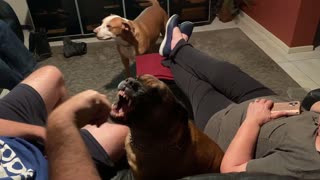These kittens are NOT happy about their new brother 😂
The last one is absolutely me...
Your best shot at pet togetherness is to get your cat and dog when they're both young. Kittens and puppies whoMany dogs and cats can live harmoniously together if introduced properly and supervised appropriately. Whether you’re adding a new cat or a new dog to your household, the top priority is always safety. A cat might be able to live safely and happily with some dogs, but not others, so even if your cat has lived with dogs before, use caution and proceed slowly when introducing your cat to a new dog. When introducing your cat to a dog, it’s best to introduce her to only one dog at a time. It is also important to have at least two people present, one to handle the dog’s leash and the other to tend to the cat. In the initial introduction, make sure that the two animals first clearly see and become aware of the presence of each other. If one of the animals hasn’t seen the other before the other gets too near, fear and panic may result. Even if the two animals appear to be exhibiting playful behavior, slow down any approaches until it’s clear that neither pet is anxious or frightened. grow up together are much more likely to get along, and they can even become close buddies. That said, if you've got an adult pet, it's possible to find a dog or cat who will coexist with him. The first thing you want to do is pay attention to the body language of both animals. Ideally, the body language of both pets will be loose and relaxed. In particular, watch how they look at each other. As you watch the dog, notice whether he can look at the cat and then look away. If he cannot, this may indicate that he is too excited or aroused. Observe the dog’s head and face; if the dog appears excessively focused on the cat, try calling him or snapping your fingers. If you can distract him relatively easily, his behavior suggests he doesn’t have an unhealthy degree of interest in the cat. If your dog has a strong prey drive, he might become very focused on the cat. (A prey drive is the inclination to seek out, chase and potentially capture animals seen as prey — usually smaller animals such as cats or rabbits.) He’ll stiffen, stare, glare, and may start barking or whining. If you see these signs, do not let the cat and dog get close to one another (yet). It’s OK if the dog pays attention to the cat, but you don’t want to see him fixated on her. How the cat looks at the dog is equally important, but pay attention to the other forms of feline body language, too. Once it is clear that the cat has seen the dog, observe whether the cat seems relaxed. A relaxed cat will move about calmly and confidently, will not glare at the new dog, and will not try to flee from the dog. If the cat is growling, hissing or attempting to scratch, it means she is currently uncomfortable. That doesn’t necessarily mean that she won’t accept the dog; it might just take a little more time.
Thank you for watching my video
-
 0:08
0:08
Funny Channel
9 months agoTheory and Practical are totally different 😂
16 -
 0:16
0:16
rumblestaff
3 years agoThese Siamese Kittens See Their Owner As A Toy
2.79K6 -
 0:10
0:10
Plodra72
3 years agoStaffordshire Terrier Gary, Not Happy about something
67 -
 2:33:02
2:33:02
Matt Kohrs
11 hours agoDJT Talks Short Squeeze, GDP Report & Live Trading || The MK Show
13.2K3 -
 2:30:43
2:30:43
AP4Liberty
4 hours agoNick Fuentes and Lauren Southern Go To War Over Sex
16.5K10 -
 22:59
22:59
Science & Futurism with Isaac Arthur
15 hours agoWill We Colonize Space?
18.3K44 -
 22:17
22:17
ErmzPlays
19 hours agoThe Fallout TV Show Is Modern Day Garbage
34K63 -
 6:47
6:47
Sideserf Cake Studio
17 hours agoReacting to Viral Cake Videos
18.7K6 -
 9:55
9:55
China Uncensored
15 hours agoChina Just Suffered a Crushing Defeat in the Pacific. And It's Thanks To You!
33.4K15 -
 18:58
18:58
TrasherFootball
16 hours agoThe Last Dynasty | S1E1 | College Football Revamped
24.4K